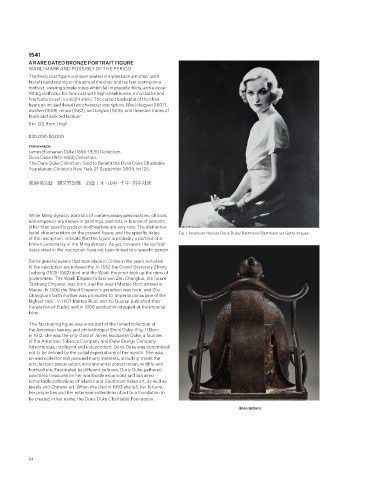Page 66 - Christies IMportant Chinese Art Sept 26 2020 NYC
P. 66
1541
A RARE DATED BRONZE PORTRAIT FIGURE
WANLI MARK AND POSSIBLY OF THE PERIOD
The finely cast figure is shown seated in a yokeback armchair, with
his left hand resting on the arm of the chair and his feet resting on a
footrest, wearing simple robes which fall in graceful folds, and a close-
fitting cloth cap, his face cast with high cheekbones, a mustache and
fine features set in a slight smile. The curved backsplat of the chair
bears an incised dated ten-character inscription, Wanli dingwei (1607),
wushen (1608), renwu (1582), and bingwu (1606), and there are traces of
black and dark red lacquer.
9 in. (22.9 cm.) high
$30,000-50,000
PROVENANCE:
James Buchanan Duke (1856-1925) Collection.
Doris Duke (1912-1993) Collection.
The Doris Duke Collection, Sold to Benefit the Doris Duke Charitable
Foundation; Christie's New York, 21 September 2004, lot 125.
或為明萬曆 銅文官坐像 萬曆丁未,戊申,壬午,丙午刻款
While Ming-dynasty portraits of contemporary personalities, officials
and emperors are known in paintings, portraits in bronze of persons
other than specific gods or bodhisattvas are very rare. The distinctive
facial characteristics on the present figure, and the specific dates Fig. 1 American Heiress Doris Duke/Bettmann/Bettmann via Getty Images.
of the inscription, indicate that the figure is probably a portrait of a
known personality of the Ming dynasty. As yet, however, the cyclical
dates cited in the inscription have not been linked to a specific person.
Some general events that took place in China in the years included
in the inscription are noteworthy. In 1582 the Grand Secretary Zhang
Juzheng (1525–1582) died and the Wanli Emperor took up the reins of
government. The Wanli Emperor’s first son Zhu Changluo, the future
Taichang Emperor, was born, and the Jesuit Matteo Ricci arrived in
Macau. In 1606 the Wanli Emperor’s grandson was born, and Zhu
Changluo’s birth mother was promoted to ‘imperial concubine of the
highest rank’. In 1607 Matteo Ricci and Xu Quanqi published their
translation of Euclid, and in 1608 production stopped at the imperial
kilns.
This fascinating figure was once part of the famed collection of
the American heiress and philanthropist Doris Duke. (Fig. 1) Born
in 1912, she was the only child of James Buchanan Duke, a founder
of the American Tobacco Company and Duke Energy Company.
Adventurous, intelligent and independent, Doris Duke was determined
not to be defined by the social expectations of her wealth. She was
an avid collector and pursued many interests, including travel, the
arts, historic preservation, environmental conservation, wildlife and
horticulture. Fascinated by different cultures, Doris Duke gathered
countless treasures on her worldwide excursions and acquired
remarkable collections of Islamic and Southeast Asian art, as well as
jewels and Chinese art. When she died in 1993 she left her fortune,
her properties and her extensive collections of art to a foundation to
be created in her name: the Doris Duke Charitable Foundation.
(inscription)
64

